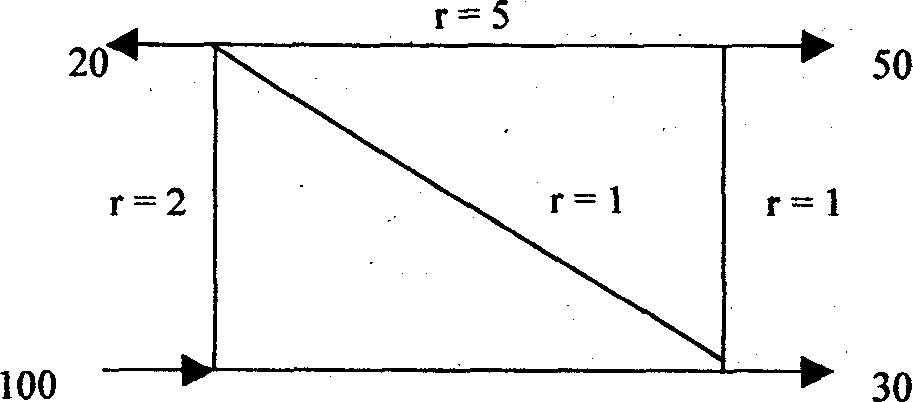Cochin University of Science and Techology (CUST) 2011-5th Sem B.Tech Civil Engineering Cochin University of Science & Technology B.E Iester ,, Fluid Mechanics I (02 Ad) - Question Paper
BTS(C)-IV -II- 021 -A
B.Tech Degree IV Semester Examination April 2011
CE 405 (A) FLUID MECHANICS I
(2002 Scheme)
Time
I.
II.
III.
IV.
V.
VI.
3 Hours Maximum Marks : 100
(a) Define the terms gauge pressure, vacuum pressure and absolute pressure.
Indicate their relative positions on a chart. (8)
(b) A rectangular door covering an opening 3 m wide and 2 m high in a vertical wall is hinged about its vertical edge by two pivots placed symmetrically 25 cm from either end. The door is locked by a clamp placed at the centre of the vertical edge. Determine the reactions at the two hinges and the clamp, when the height of water is 1.5 m above the top edge of the opening.
(12)
(*)
(12)
OR
(a) Define and distinguish between stream line, path line and streak line.
(b) A cylinder has a diameter 30 cm and a specific gravity of 0.75. What is the maximum permissible length of the cylinder in order that it may float in water with its axis vertical.
(a) What is a venturimeter? Derive an expression for the discharge through a venturimeter. (8)
(b) Water flows in a 30 cam diameter pipe. Two pitot tubes are installed in a pipe, one on the centre line and the other 7.5 cm from the centre line. If the velocities at the two points are 3 m/s and 2 m/s respectively, calculate the reading on the differential mercury manometer connected to the two tubes. (12)
OR
(a) Describe the different methods for the determination of the various hydraulic coefficients for an orifice. (10)
(b) A channel is conveying 0.6 m3/sec of water. Assuming that an error of 0.15 cm may be made in measuring the head, determine the percentage error in discharge resulting (i) from the use of a right angled triangular weir (ii) from the use of a suppressed rectangular weir 60 cm long. Assume the coefficient of
discharge as 0.6. (10)
(a) Derive Hagen Poiseuilles equation for laminar flow through a pipe. (9)
(b) A steady flow of oil (specific gravity = 0.85) occurs in a 10 cm diameter pipe which has a downward slope of 1 in 100. If the discharge measured is 2 litres per second, determine the pressure drop between two points on the pipe 200 m
apart. Take dynamic viscosity of oil as 1.2 poise. (11)
OR
(a) Explain Darcys law for flow through a porous media. (8)
(b) A smooth brass pipeline 7.5 cm in diameter and 900 m long carries water at the rate of 7 litres per second. If the kinematic viscosity of water is 0.0195 stokes, calculate the loss of head, wall shearing stress, centerline velocity and shear
stress and velocity at 2.5 cm from the centre line. (12)
(P.T.O.)
VII. (a) With a neat sketch, explain the boundary layer growth along a long thin flat
plate. (8)
(b) Two reservoirs are connected by three pipes laid in parallel, their diameters are
d, 2d and 3d respectively, and they are of the same length, L. Assuming friction factor to be the same for all pipes, determine the discharge through each of the larger pipes if the smallest pipe is discharging 1 m3/sec. (12)
OR
VIII. For a pipe network shown in the figure, determine the flow in each pipe. The value of n may be assumed as 2. Use Hardy Cross method.

(20)
IX. (a) What are the methods of dimensional analysis? Describe any one method in
detail.
(9)
(b) Assuming that rate of discharge Q of a centrifugal pump is dependent upon the mass density d of fluid, pump speed N (rpm), the diameter of impeller D, the pressure p and viscosity of fluid m, show using the Buckinghams II - theorem
ptvijuiv p uiiu ruvuiiikj ui tiuiu iii} jiiurr ujmg uiw uu
that it can be expressed by Q = {ND3f-~
V N
where H =
iD2
ND
head and V = kinematic viscosity of the fluid.
(ID
(9)
(ID
OR
X. (a) Explain the different types of hydraulic similarities that must exist between a
prototype and its model.
(b) A 1:10 scale model of a submarine moving far below the surface of water is tested in a water tunnel. If the speed of the prototype is 8 m/sec, determine the corresponding velocity of water in the tunnel. Also determine the ratio of the drag for the model and the prototype. Kinematic viscosity of water and sea water is 1.121 x 10'2 cm2/sec and 1 x 10'2 cm2/sec respectively. Specific gravity of sea water is 1.025.
|
Attachment: |
| Earning: Approval pending. |
